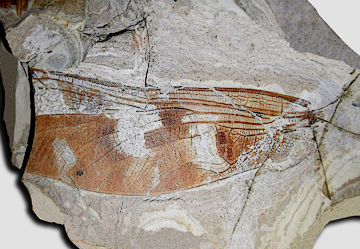Abstract
Baltic amber forms the largest known Konservat-Lagerstätte of fossil plant resin and the richest repository of fossil insects of any age on Earth. Despite a long history of palaeobiological research of Baltic amber (over 200 years) and really intensive taxonomic study in the last decade, many interesting and new bioinclusions await scientific attention. In the current paper, the brief report of an unique large flower chafer inclusion from the Early Tertiary Baltic amber is provided. The author decided not to formally create a new genus and not to subjectively assign the Eocene beetle to an extant genus. However, the specimen seems to be remarkable and surprising in different aspects. The reported Eocene beetle is: 1) one of the oldest members of the subfamily Cetoniinae and also the earliest fossil record of the tribe Trichiini; 2) the first known representative of the subfamily in Baltic amber; 3) the largest known beetle fossilized in amber; and 4) an unique example of mineralized fossil included in amber.
References
Bezděk, A. (2016) Subfamily Cetoniinae Leach, 1815. In: Löbl, I. & Löbl, D. (Eds.), Catalogue of Palaearctic Coleoptera. Vol. 3. Scarabaeoidea-Scirtoidea-Dascilloidea-Buprestoidea-Byrrhoidea. Revised and updated edition. Brill, Leiden/Boston, pp. 367–412.
Bukejs, A., Alekseev, V.I. & Pollock, D.A. (2019) Waidelotinae, a new subfamily of Pyrochroidae (Coleoptera: Tenebrionoidea) from Baltic amber of the Sambian peninsula and the interpretation of Sambian amber stratigraphy, age and location. Zootaxa, 4664 (2), 261–273.
https://doi.org/10.11646/zootaxa.4664.2.8
Krell, F.T. (2000) The fossil record of Mesozoic and Tertiary Scarabaeoidea (Coleoptera: Polyphaga). Invertebrate Taxonomy, 14, 871–905.
https://doi.org/10.1071/IT00031
Krell, F.T. (2006) Fossil record and evolution of Scarabaeoidea (Coleoptera: Polyphaga). The Coleopterists Bulletin, 60 (5), 120–143.
https://doi.org/10.1649/0010-065X(2006)60[120:FRAEOS]2.0.CO;2
Krell, F.T. (2007) Catalogue of fossil Scarabaeoidea (Coleoptera: Polyphaga) of the Mesozoic and Tertiary. Version 2007. Denver Museum of Nature and Science Technical Report, 2007–8, 1–79.
Krikken, J. (1984) A new key to the suprageneric taxa in the beetle family Cetoniidae, with annotated lists of the known genera. Zoologische Verhandelingen, 210, 1–75.
Martínez-Delclòs, X., Briggs, D.E.G. & Peñalver, E. (2004) Taphonomy of insects in carbonates and amber. Palaeogeography, Paleoclimatology, Palaeocology, 203, 19–64.
https://doi.org/10.1016/S0031-0182(03)00643-6
Motschulsky, V.I. (1856) Voyages. Lettres de M. de Motschulsky a M. Ménétriés. No. 3. New York le 15 Juillet 1654. Études Entomologiques, 5, 21–38.
Poinar, G.J. (2011) Paleotrichius dominicanus n. gen., n. sp. (Coleoptera; Cetoniidae), a flower beetle in Dominican amber. Historical Biology, 23, 2–3, 109–113.
https://doi.org/10.1080/08912963.2010.482417
Ratcliffe, B.C., Smith, D.M. & Erwin, D.M. (2005) Oryctoantiquus borealis, new genus and species from the Eocene of Oregon, U.S.A., the world’s oldest fossil dynastine and largest fossil scarabaeid (Coleoptera: Scarabaeidae: Dynastinae). The Coleopterists Bulletin, 59 (1), 127–135.
https://doi.org/10.1649/0010-065X(2005)059[0127:OBNGAS]2.0.CO;2
Wappler, T. (2003) Die Insekten aus dem Mittel-Eozän des Eckfelder Maares, Vulkaneifel. Mainzer Naturwissenschaftliches Archiv Beiheft, 27, 1–234.
Zang, R. (1905) Über Coleoptera Lamellicornia aus dem baltischen Bernstein. Sitzungsberichte der Gesellschaft Naturforschender Freunde zu Berlin, 1905, 197–205.

